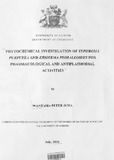| dc.description.abstract | The air dried and ground E. psoraleoides roots were exhaustively extracted with
dichloromethane/methanol (1: 1) by cold percolation. The extract was partitioned between
water and ethyl acetate.
Chromatographic separation of the ethyl acetate layer led to the isolation of four
compounds. These were identified as 4',5-dihydroxy-2',7-dimethoxyisoflavone (1), 4',5,7trihydroxy
coumaronochromone (2), 4',7"-bisgenistein (3) and 4',5,7-trihdroxy-2'methoxyisoflavone
(4). Similar treatment of the stem of T purpurea yielded four
compounds, stigmasterol (5); lanceolatin B (6); semiglabrin (7); terpurinflavone (8);
lanceolatin A (9). Of these, compound 8 i§ a novel compound. The characterization of
these compounds was based on spectroscopic techniques (IH NMR, l3C NMR, 2D NMR,
UVandMS).
The crude extact of E. psoraleoides, T purpurea and some of the pure compounds were
tested for smooth muscle and blood vessel relaxant activities. The methanol extract of the
roots of E. psoraleoides (88 ug/ml.) had the highest relaxant effect (13 mm) on isolated
aorta. The ethyl acetate fraction of the dichloromethane/methanol (1: 1) extract of T
purpurea stem, stigmasterol (5), lanceolatin B (6) relaxed the aorta by 9 mm, 6 mm and 10
mm respectively. This indicates that E. psoraleoides and T purpurea may promote penile
erection.
The crude extract of E.psoraleoides (roots) had an insignificant effect on bronchial muscle
where as the ethyl acetate fraction of dichloromethane/methanol extract of T purpurea and
its pure compound semiglabrin (7) relaxed the bronchial smooth muscle by 1.5 ~L and
15~L respectively. The potent relaxant activity by semiglabrin (7) could be attributed to its
aromatic groups. This probably explains the traditional use of T purpurea for the
management of chest tightness.
The methanol extract of the roots of E. psoraleoides (2.5 g/kg) was further tested for
mating behavior on mice using yohimbine (360 mg/kg) and sildenafil (600 mg/kg) as a
reference drugs. The results indicated that E. psoraleoides (roots) extract may promote
erection.
The crude extracts of E. psoraleoides, T purpurea and isolated compounds from T
purpurea were also tested for antiplasmodial activities. The crude extracts showed
antiplasmodial activities with ICso values of 9.33± 0.38 and 11.43± 0.47 ug/rnl for E.
psoraleoides, and 10.47± 2.22 ug/rnl and 12.06± 5.53 ug/rnl for T purpurea, against
chloroquine-sensitive (D6) and chloroquine-resistant (W2) strains of Plasmodium
falciparum, respectively. The novel compound, terpurinflavone (9) showed highest
antiplasmodial activity with an ICso = 2.73± 1.16 ug/ml and 1.36± 0.12 ug/rnl against W2
and D6 strains respectively. Laceolatin A (9) also showed significant activity against (06)
and (W2) strains of P. falciparum with ICso value of 3.82 ± 1.00 and 3.82 ± 1.04flg/ml,
respectively.
The crude extracts of E. psoraleoides, T purpurea and some of the pure compounds
isolated from T purpurea were further tested for antimicrobial activity. The crude extract
of E. psoraleoides showed an inhibition zone of 12 mm against Candida albicans at a
concentration of 1.8 mg/disc while the novel compound terpurinflavone (8) showed an
inhibition zone of 16 mm against Microsporum gypsum at a concentration 50 ug/disc, The
crude extract of T purpurea and the five pure compounds isolated from this extract were
inactive against Staphylococcus aureus, Pseudomonas eruginosa, Candida albicans,
Cryptococcus neoformans, Trichphyton mentagrophytes and Microsporum gypsum. | en |

